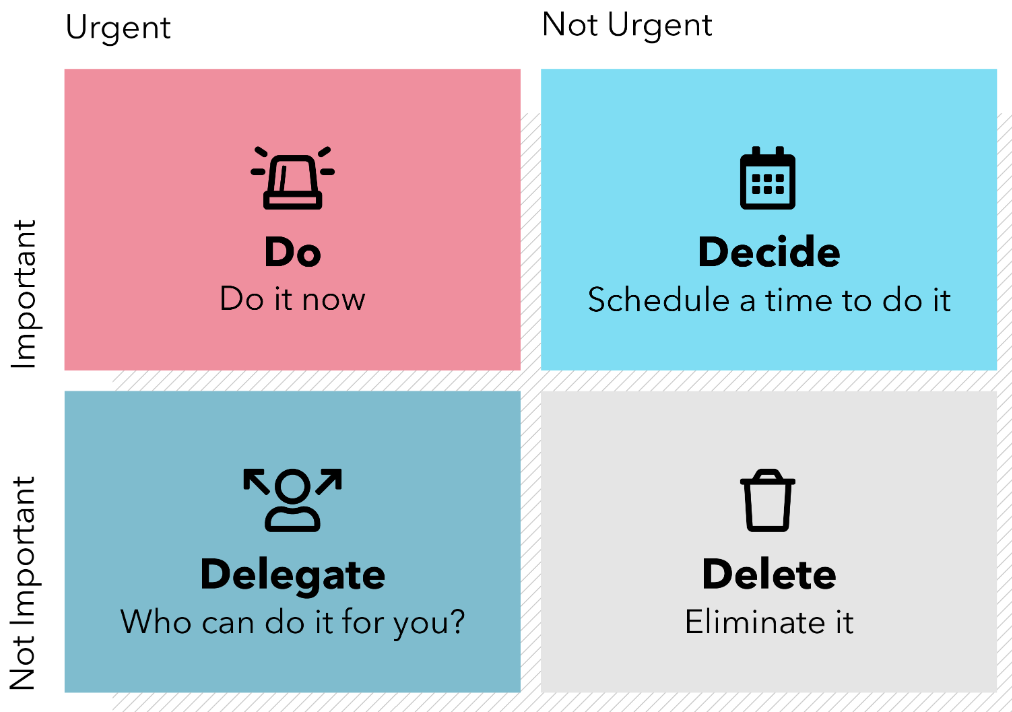important-urgent-Eisenhower-decision-matrix

inc.com article on Eisenhower Matrix
The following is from inc.com:
In the fast-paced world we live in, effective time management and decision-making skills are essential for successful leadership. Leaders need systems and tools to aid them in prioritizing tasks and maximizing productivity. A popular one is the Eisenhower Matrix, also known as the Urgent-Important Matrix.
During his presidency, Eisenhower faced numerous demands on his time, including managing the Cold War, domestic affairs, and other national issues. To cope, Eisenhower employed a method of task prioritization that later became known as the Eisenhower Matrix. Eisenhower's reputation for productivity and decision-making skills contributed to the association of the matrix with his name.
This matrix provides a framework for evaluating tasks based on two factors: urgency and importance. It enables leaders to make informed decisions about how to allocate their time and efforts.
Understanding the Eisenhower Matrix
The Eisenhower Matrix is a simple yet powerful visual tool that divides tasks into four quadrants, on the basis of two key factors: urgency and importance. After an assessment of each situation, tasks are classified into one of the following categories, which help orient the leader to what to do next in making the right decision.
Urgent and Important: "Do" Tasks falling under this category require immediate attention and are crucial to achieving goals or meeting deadlines. Research has shown that effective leaders prioritize tasks in this quadrant to address critical issues promptly (Smith et al., 2018). By tackling urgent and important tasks head-on, leaders can prevent potential crises and maintain a proactive approach to their responsibilities.
Important but Not Urgent: "Decide"
This quadrant comprises tasks that are significant but do not have an immediate deadline or require immediate attention. Papers on leadership decision-making by Thompson and Brown (2017) indicate that effective leaders allocate sufficient time for important but not urgent tasks. These tasks may involve long-term planning, goal setting, skill development, and relationship building. By dedicating time to these activities, leaders can foster innovation, personal growth, and long-term success. A decision can be made but not necessarily executed right away.
Urgent but Not Important: "Delegate"
Tasks categorized as urgent but not important are often distractions or interruptions that hinder productivity. Effective leaders aim to minimize time spent on these tasks or delegate them to others whenever possible. Research by Johnson and Williams (2019) supports this notion, emphasizing the significance of delegating nonessential tasks to focus on high-impact activities. By reducing time spent on tasks that do not contribute directly to key goals, leaders can improve their efficiency and maintain focus on strategic objectives.
Not Urgent and Not Important: "Delete"
This quadrant comprises tasks that are neither urgent nor important. These tasks are often time-wasters and can include excessive social media use, unproductive meetings, or trivial activities that make leaders fall prey to "action addiction." Effective leaders recognize the importance of minimizing or eliminating these tasks to free up time for more meaningful and productive activities. According to a study by Davis et al. (2016), leaders who actively manage their time and avoid unnecessary activities achieve higher levels of productivity and satisfaction.
Applying the Eisenhower Matrix to leadership decision-making
The Eisenhower Matrix serves as a valuable decision-making tool for leaders at all levels. By using this framework, leaders can prioritize tasks effectively, avoid unnecessary stress, and optimize their time management. Research studies have shown that effective leaders who employ the Eisenhower Matrix demonstrate higher levels of productivity, improved decision-making, and better overall performance (Smith et al., 2018; Johnson and Williams, 2019).